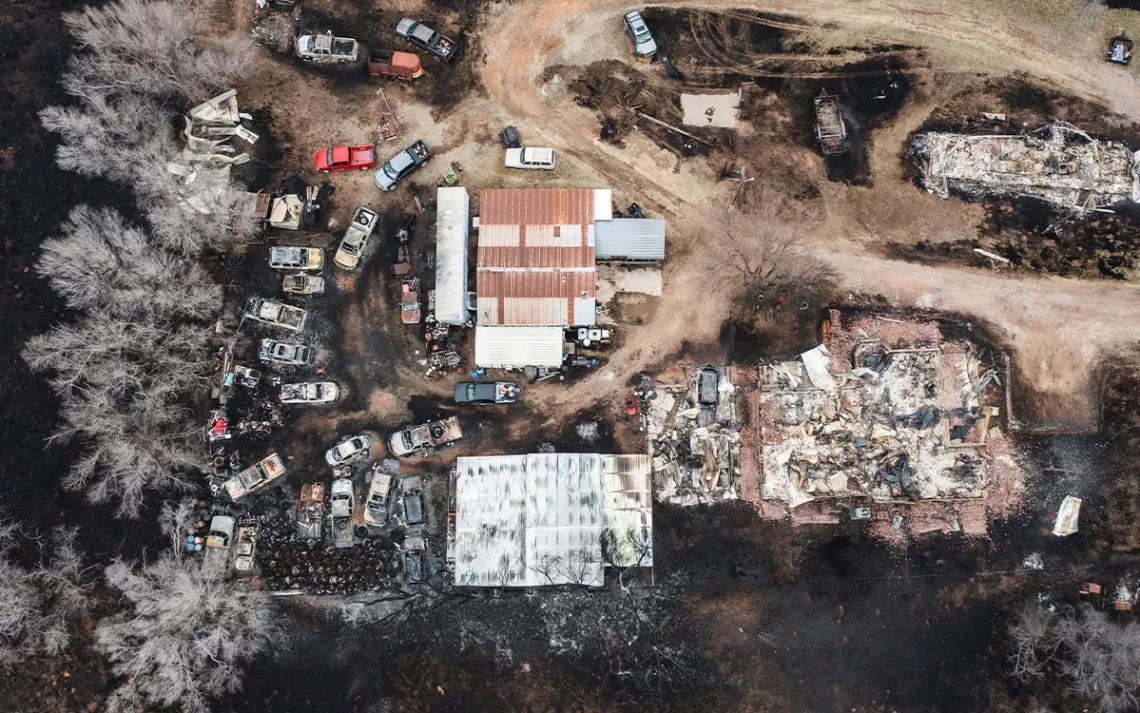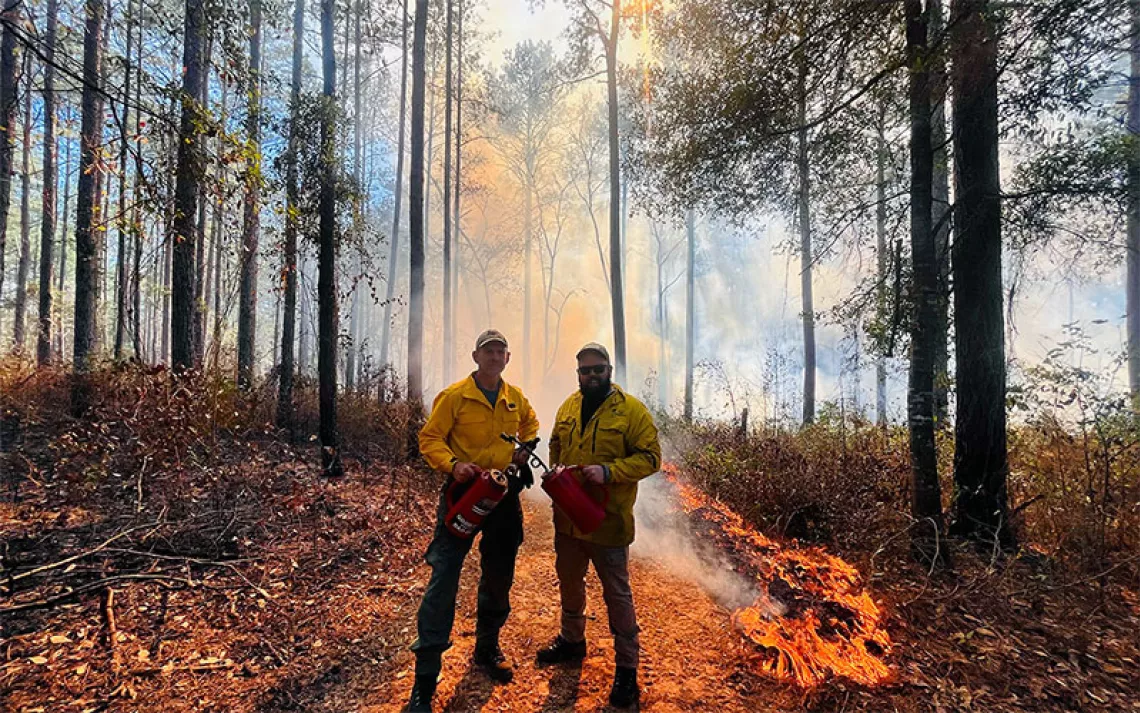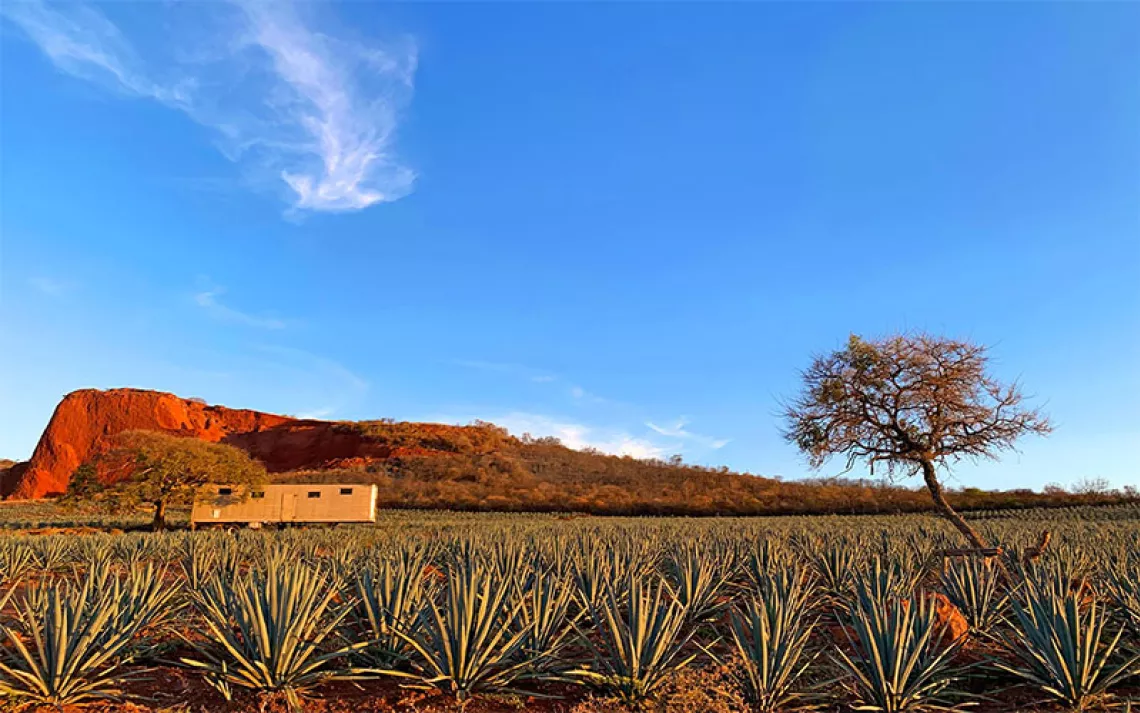The Epic Wildfire in the Texas Panhandle Is Just a Preview
Texas officials go to bat for oil and gas while the climate-fueled Smokehouse Creek Fire still rages

Destruction from the Smokehouse Creek Fire in Canadian, Texas. | Photo by David Erickson/AP
On February 26, a tiny flame sparked a mile north of the ranching community of Stinnett, Texas. This part of the Texas Panhandle is sparsely populated—Hutchinson County has 20,000 people and roughly the same number of cows—so no one saw the smoldering patch of tall, dry grass where two county roads intersect. By the time area residents took notice of the smoke, it was too late: The fire had already spread into fallow fields and untamed barrow ditches, morphing into a monster over the course of mere hours. By evening, the blaze—soon dubbed the Smokehouse Creek Fire—had reached 62 square miles. Firefighters were dispatched from all over Texas and beyond to try to prevent the entire Panhandle from going up in smoke.
Three weeks later, firefighters have finally extinguished the Smokehouse Creek Fire and several other blazes that started around the same time. They destroyed 500 structures, mostly in the towns of Fritch and Canadian, and forced hundreds more evacuations as it devoured barbed-wire fences and killed upwards of 7,000 head of cattle. The scar it left on the Panhandle landscape is visible from space. Two people were killed: an 83-year-old grandmother in Stinnett who died after her home caught fire and the volunteer fire chief in Fritch, who had battled the blaze for over a week. The fire’s size—1 million acres—was unprecedented in Texas. It was eight times bigger than California’s 2018 Camp Fire, the most destructive in that state’s history.
The Camp Fire was caused by faulty transmission lines owned by Pacific Gas & Electric. (The utility filed for bankruptcy protection the following year.) Already, Xcel Energy, a Minneapolis-based electric utility and natural gas delivery company, has told state fire investigators that its equipment apparently started the Smokehouse Creek blaze. A rancher in Stinnett has filed a lawsuit against the company, alleging gross negligence in the maintenance and inspection of its transmission equipment. Xcel Energy has denied negligence, stating that a subcontractor, Osmose Utilities Services, is responsible for conducting federally mandated inspections of the company’s power poles and electrical lines. A separate fire that was sparked in the Panhandle about the same time as the Smokehouse Creek Fire also appears to have been caused by electrical equipment, state investigators say. It’s a familiar cause of Texas wildfires. In 2016, malfunctioning power lines running to a pumpjack near Pampa leaked molten metal on dry grass, sparking a fire that burned 135,000 acres and killed three people. In 2011, fallen power lines ignited a blaze in Bastrop County, just east of Austin, reducing 1,500 homes to rubble and killing two people before being extinguished.
Utility-related fires, in fact, are wreaking havoc across the United States. Since 2017, fires related to electricity transmission have burned at least 3 million acres, much of it in the heavily wooded Pacific Northwest. The companies responsible for them, such as PG&E, have been subject to intense public criticism and congressional inquiries. Until now, Xcel has managed to avoid such a glaring spotlight. In recent years, the company has enjoyed a reasonably good reputation with environmentalists for its focus on building out wind energy and its pledge to go carbon-free by 2050. But in March 2023, it was discovered that an Xcel-owned nuclear power plant in Minnesota had leaked 400,000 gallons of radioactive water—a fact that was concealed from the public for months. Now the company is contending with another round of bad press.
In September, a commission formed by the Biden administration to study wildfire mitigation released a 340-page report containing 140 recommendations to counter the growing problem. It suggested safety measures such as upgrading utility lines, replacing old poles, and installing sensors to detect fallen poles and sagging lines. The report also notes that climate change makes the task more urgent: “Climate change poses an additional challenge by fundamentally shifting wildfire risk, fire behavior, and the trajectory of postfire recovery in ways that current fire behavior models … are not designed to meet.”
Climate change has accelerated wildfires in recent years, increasing their frequency and destructive potential, says Amy Bailey, director of climate resilience and sustainability at the Center for Climate and Energy Solutions. “The wildfires that we're seeing are becoming larger, and they're increasingly burning closer to communities,” she says. “We saw a very large increase in the number of structures lost to wildfires over the past couple of decades, and also moving into places that haven't had as much history of wildfires—communities and landscapes that might not be accustomed to something like that.” Climate change effectively doubled the number of large fires in the western United States between 1984 and 2015, along with exposing wildfire-prone areas to extended periods of fire danger. Melanie McQuiddy, the Stinnett rancher who filed suit against Xcel Energy, put it this way in her complaint: “So-called wildfire seasons have been stretched into an almost year-round schedule of high fire risk.”
In December the Biden administration announced new rules to combat methane emissions from the oil and gas sector. Methane is responsible for “one-third of the warming from greenhouse gases occurring today,” the EPA wrote, adding that oil and gas operations represent the nation’s largest industrial sources of the “climate super-pollutant.” The plan’s mandates that oil and gas companies plug abandoned wells and invest in cleaner technologies immediately drew the ire of officials in oil-friendly Texas. State Attorney General Ken Paxton, who has been under indictment for the last decade on fraud charges and who was impeached last year by the Texas legislature, filed suit against the EPA over the new rule. On March 8, as firefighters risked their lives to fight the Smokehouse Creek Fire across a piece of land the size of Delaware, Paxton was busy filing the complaint with a federal judge. The rule, he said, “establishes onerous emissions standards for the oil and gas industry that would require producers to drastically update infrastructure.”
That’s a typical reaction from a Texas official after being smacked by a natural disaster. Consider Governor Greg Abbott’s response to the February 2021 winter storm that left millions of Texas without power in frigid temperatures. Though the state’s power grid failure was largely due to frozen natural gas lines and stuttering coal-fired power plants, Abbott told conservative pundit Sean Hannity that the failure was due to inoperable wind turbines and solar panels. “The Green New Deal would be a deadly deal for the United States of America,” Abbott said of the winter storm that killed 246 people. Many more are likely to die—from ice, and from fire—if Abbott and other Texas officials continue to ignore the threat of climate change.
 The Magazine of The Sierra Club
The Magazine of The Sierra Club







